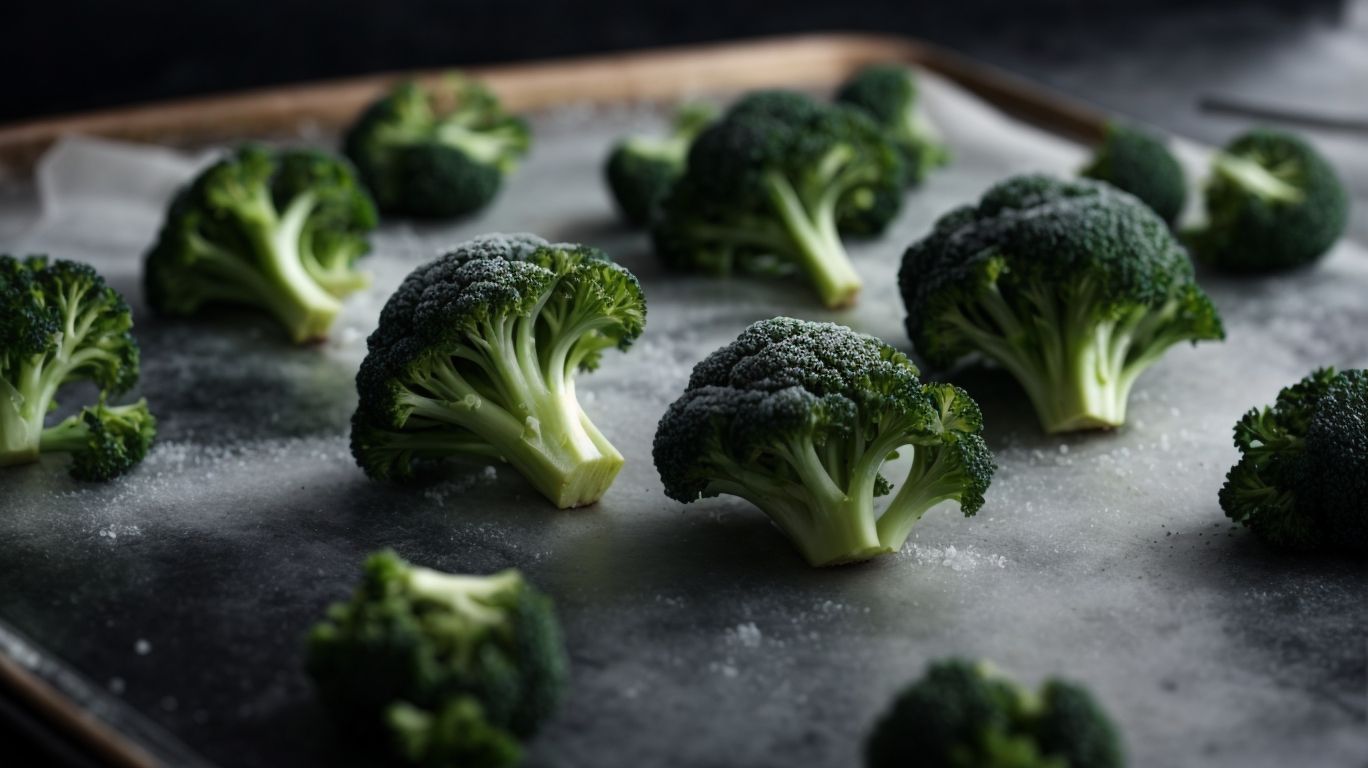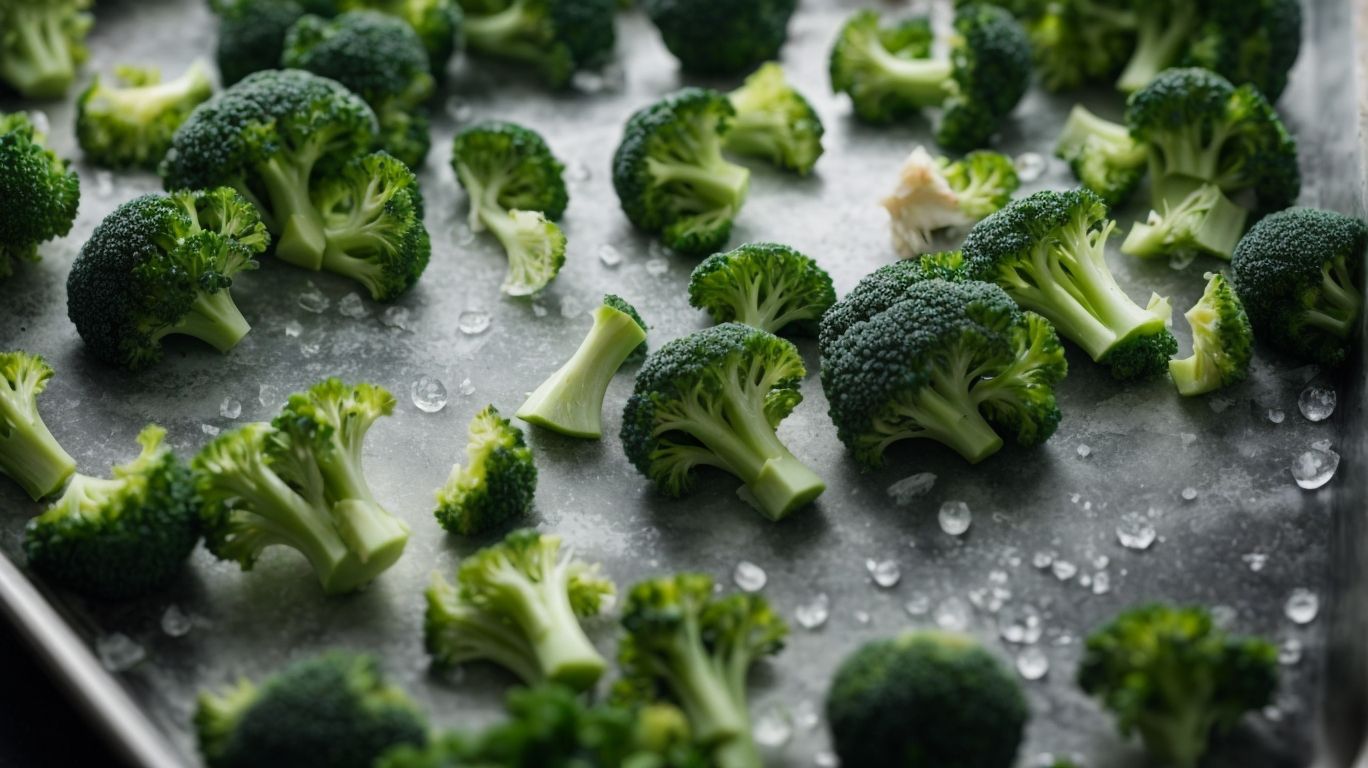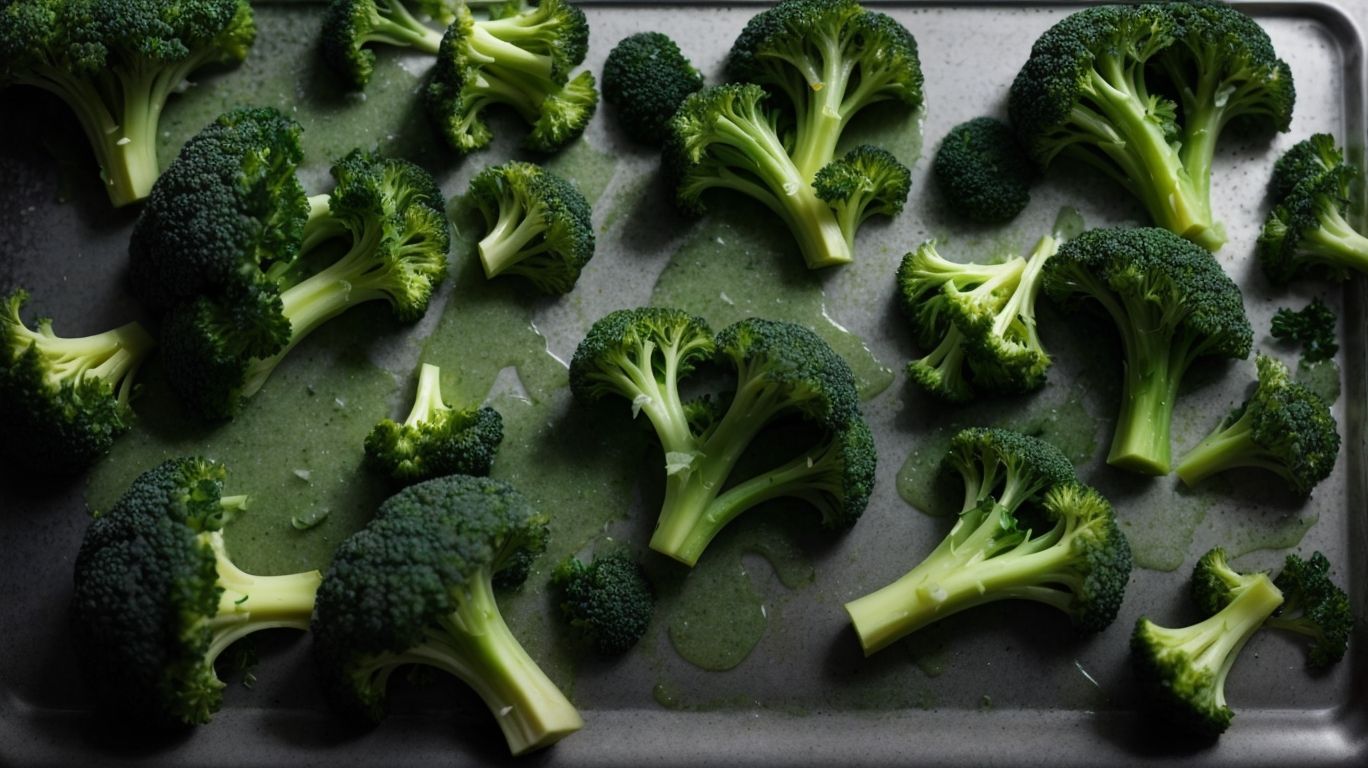How to Bake Frozen Broccoli?
Looking to add some green goodness to your meals without the hassle of chopping and prepping fresh broccoli?
Consider frozen broccoli! Discover what frozen broccoli is and why it’s a convenient option. Explore methods to thaw frozen broccoli and how to bake it perfectly.
From adding cheese to trying different seasonings, learn how to enjoy baked frozen broccoli in various ways. Get expert tips to elevate your broccoli game!
Key Takeaways:
What is Frozen Broccoli?
Frozen broccoli is broccoli that has been blanched and flash-frozen to preserve its freshness and nutrients, offering a convenient and long-lasting option compared to fresh broccoli.
Freezing broccoli involves blanching the florets in boiling water briefly before submerging them in ice water to halt the cooking process and retain their vibrant color and nutrients. This method locks in the goodness of the vegetable, making it a great choice for busy individuals or those looking to reduce food waste. Frozen broccoli is packed with essential vitamins such as vitamin C, K, and A, as well as folate and fiber, making it a nutritious addition to your diet.
When comparing frozen and fresh broccoli, frozen broccoli often retains more of its nutrients as it is frozen at its peak ripeness. This contrasts with fresh broccoli, which may have lost some nutrients during transportation and storage. While fresh broccoli is ideal for immediate consumption, frozen broccoli is a convenient standby to have on hand for quick and easy meal preparation.
Why Use Frozen Broccoli?
Using frozen broccoli can be a time-saving and practical choice for preparing quick and easy side dishes like roasted broccoli without compromising on taste or nutritional value.
One of the key advantages of opting for frozen broccoli is its convenience. Having a bag of frozen florets in your freezer means you can skip the washing, cutting, and prepping, reducing your cooking time significantly. Frozen broccoli is available year-round, ensuring you can enjoy this nutritious vegetable regardless of the season.
Versatility is another highlight of frozen broccoli. You can easily incorporate it into various recipes beyond simple roasting, including stir-fries, casseroles, pasta dishes, and soups, providing a nutritious boost to your meals with minimal effort.
How to Thaw Frozen Broccoli?
Thawing frozen broccoli can be done through various methods like the microwave, stovetop, or oven, ensuring it reaches the desired consistency for cooking.
One of the quickest ways to thaw frozen broccoli is by using the microwave. Simply place the broccoli in a microwave-safe dish with a bit of water, cover it with a damp paper towel, and microwave on high in short bursts, stirring occasionally until thawed.
Another method is the stovetop approach, where you can blanch the broccoli in boiling water for a few minutes or steam it over simmering water until tender.
For those who prefer the oven, spread out the frozen broccoli on a baking sheet, drizzle with olive oil, sprinkle with seasoning, and bake until thawed and slightly crispy.
The Microwave Method
The microwave method for thawing frozen broccoli involves placing the broccoli in a microwave-safe dish with a bit of water and heating it in short intervals until it’s defrosted.
To ensure the best results when using the microwave, it’s recommended to cover the dish with a microwave-safe lid or plastic wrap to help retain moisture during the thawing process. Set the microwave to a low power level, typically around 30-50% power, to thaw the broccoli gently and evenly without starting the cooking process prematurely.
Remember to stir the broccoli periodically, redistributing it to help promote uniform thawing. It’s crucial to exercise caution when handling the dish after microwaving as it can be hot. To prevent overcooking, check the broccoli frequently, adjusting the timing as needed.
The Stovetop Method
Thawing frozen broccoli on the stovetop involves simmering the broccoli in a pot of water over low heat until it softens to the desired consistency.
For optimal results, ensure that the water level doesn’t cover the broccoli completely. Keeping the lid partially open during the simmering process can help prevent overcooking and retain the broccoli’s vibrant color and nutrients. A general rule of thumb is to cook the broccoli for around 5-7 minutes, but this may vary based on the size of the florets and your desired level of tenderness.
Stovetop thawing is a convenient method that allows you to monitor the broccoli’s progress closely and adjust the cooking time according to your preferences.
The Oven Method
Thawing frozen broccoli in the oven involves spreading the broccoli on a baking sheet and roasting it at a low temperature until it softens and becomes ready for further cooking.
To ensure even thawing and proper texture, it’s essential to preheat the oven to 300°F before placing the broccoli in. This gentle heat allows the broccoli to gradually thaw without becoming overcooked or mushy.
Depending on the size of the broccoli florets and the oven’s temperature accuracy, the thawing process typically takes around 15-20 minutes. To avoid uneven thawing, it’s advisable to turn the broccoli halfway through the process.
Once the broccoli is soft and thawed, you can adjust the oven to a higher temperature if you plan to further roast or season the broccoli for added flavor and aroma.
How to Bake Frozen Broccoli?

Credits: Poormet.Com – Mark Johnson
Baking frozen broccoli is a simple process that involves preparing the broccoli on a sheet pan, seasoning it, and roasting it in the oven until it reaches a crispy and flavorful state.
To start, preheat your oven to 400 degrees Fahrenheit to ensure it’s ready to bake the broccoli to perfection. While the oven is heating up, spread the frozen broccoli florets evenly on a baking sheet. Drizzle some olive oil over the broccoli, sprinkle salt, pepper, and any herbs or spices of your choice for added flavor.
Once your oven is preheated, place the baking sheet with the seasoned broccoli in the oven and let it roast for about 20-25 minutes, or until the edges are nicely browned and crispy. Remember to turn the broccoli halfway through the cooking time to ensure even browning.
Preparation of Frozen Broccoli for Baking
Preparing frozen broccoli for baking involves tossing the broccoli florets in olive oil and seasoning them with Montreal steak seasoning or other preferred spices for added flavor.
To ensure each floret is evenly coated with the seasoning, it is recommended to place the broccoli in a large bowl and drizzle the olive oil. Then, sprinkle the desired amount of spices over the broccoli and gently toss until all pieces are well-seasoned. A key tip is to use a light hand when seasoning to avoid overwhelming the natural taste of the broccoli.
Once seasoned, spread the broccoli out on a baking sheet in a single layer to promote even cooking and maximize flavor absorption.
The Baking Process
The baking process for frozen broccoli involves placing the seasoned broccoli on a sheet pan, roasting it in the oven until it’s caramelized and tender, and finishing with a drizzle of lemon juice for a refreshing touch.
When preparing frozen broccoli, it’s essential to preheat your oven to 400°F to ensure a hot enough environment for caramelization. Spread out the seasoned broccoli florets evenly on a sheet pan, making sure not to overcrowd them to allow proper air circulation. Roast the broccoli in the oven for approximately 20-25 minutes, or until the edges are slightly crispy and the stems are fork-tender, providing that perfect contrast in textures. Once out of the oven, a squeeze of fresh lemon juice over the roasted broccoli not only adds brightness but also enhances the overall flavor profile with a hint of acidity.
How Long to Bake Frozen Broccoli?
The ideal baking time for frozen broccoli typically ranges from 20 to 25 minutes at a moderate temperature, allowing the broccoli to achieve a roasted flavor and crispy texture.
It’s essential to periodically check the broccoli’s tenderness while it bakes to ensure it reaches the desired level of doneness. If you prefer a softer texture, you can extend the baking time slightly, keeping an eye out for any signs of overcooking. Conversely, if you enjoy a more roasted flavor and crunchier texture, sticking to the lower end of the recommended baking time range is advisable.
What are the Different Ways to Bake Frozen Broccoli?

Credits: Poormet.Com – Randy Green
There are numerous ways to bake frozen broccoli, including incorporating it into dishes with roasted cauliflower, brussels sprouts, or other roasted vegetables for a flavorful and varied meal.
One creative option to enhance the flavors when baking frozen broccoli is to experiment with a variety of seasonings such as garlic powder, paprika, or a squeeze of lemon juice, adding a zesty twist to your dish.
You can elevate the dish by creating a colorful and nutritious roasted vegetable medley, showcasing the versatility of baked frozen vegetables. Think of pairing broccoli with carrots, bell peppers, and cherry tomatoes for a vibrant and delicious combination that’s as visually appealing as it is tasty.
Baking Frozen Broccoli with Cheese
Enhance the flavor of baked frozen broccoli by sprinkling freshly grated parmesan cheese on top before or during the baking process, adding a rich and savory element to the dish.
Regarding selecting the perfect cheese for your baked frozen broccoli, consider opting for a combination that melts well and complements the earthy flavor of the broccoli. Gruyère, cheddar, or mozzarella are great choices that provide a gooey texture and enhance the overall taste. To achieve that perfect golden and gooey cheese topping, you can either layer the cheese on the broccoli before baking or sprinkle it generously towards the end of the cooking time.
Ensure the cheese is grated finely to allow it to melt evenly and create that irresistible crust on top of the broccoli. Preheating the oven to the recommended temperature is crucial to achieving a uniform and perfectly melted cheese topping. Depending on the type of cheese used and your desired level of crispiness, baking times may vary. Keep a close eye on the broccoli as it bakes to avoid over-browning or burning the cheese, and enjoy a deliciously cheesy broccoli dish that is bound to be a crowd-pleaser!
Baking Frozen Broccoli with Seasonings
Experiment with a variety of seasonings like roasted broccoli seasoning blends or homemade spice mixes to elevate the flavors of baked frozen broccoli and create a unique roasted vegetable recipe.
Regarding store-bought options, consider lemon herb seasoning or garlic parmesan blend for a zesty kick or a cheesy twist to your broccoli. These ready-made blends are convenient and can add remarkable depth to the dish without much effort. On the other hand, if you enjoy a hands-on approach, crafting your own spice mixes allows for complete control over the ingredients and flavor intensity. Think about combining paprika, cumin, and a pinch of chili powder for a smoky, slightly spicy profile that complements the natural sweetness of the broccoli.
Baking Frozen Broccoli in Casseroles
Incorporate baked frozen broccoli into casseroles with roasted frozen brussels sprouts, cauliflower, or a mix of other vegetables to create hearty and satisfying one-dish meals.
For a flavorful casserole, start by layering the baking dish with a base of cooked grains like quinoa or brown rice. Next, add a generous portion of the baked frozen broccoli along with the roasted frozen brussels sprouts and cauliflower. To enhance the dish, sprinkle shredded cheese or a creamy bechamel sauce on top before baking to create a golden crust.
When selecting complementary ingredients, consider adding protein options such as diced chicken, turkey, or tofu for a balanced meal. Incorporating herbs and spices like garlic, thyme, or rosemary can elevate the casserole’s taste profile.
Tips for Baking Frozen Broccoli
To achieve perfectly baked frozen broccoli, consider tips like adding a squeeze of lemon juice for brightness, ensuring the broccoli is spread evenly on the sheet pan for crispiness, and avoiding overcrowding during baking.
For enhanced flavor variations, try sprinkling some garlic powder or parmesan cheese over the broccoli before baking. This can elevate the taste profile and add a savory kick to the dish.
Regarding presentation, consider garnishing the baked broccoli with a sprinkle of crushed red pepper flakes or some freshly chopped herbs like parsley or thyme. Not only does this enhance the visual appeal, but it also adds a pop of flavor.
If you encounter issues like the broccoli turning out mushy, try increasing the oven temperature slightly and reducing the baking time. This can help maintain the desired texture while ensuring that the broccoli is cooked through.
How to Prevent Frozen Broccoli from Becoming Mushy?
Avoiding mushy frozen broccoli involves key steps such as preheating the oven, ensuring proper spacing on the sheet pan, and monitoring the baking time closely to achieve a crispy and flavorful outcome.
To maintain the texture of baked frozen broccoli, it is crucial to thaw the broccoli before baking to reduce excess moisture. Seasoning with a blend of herbs, spices, and a drizzle of olive oil can enhance the flavor profile while creating a delicious crust. Utilizing a high oven temperature, around 400°F (200°C), is recommended for achieving that perfect roasted finish without overcooking the broccoli. Flipping the broccoli halfway through the baking process ensures even browning and consistent crispiness.
How to Add Flavor to Baked Frozen Broccoli?
Enhance the flavor of baked frozen broccoli with creative seasoning ideas like parmesan cheese, garlic powder, or custom spice blends to achieve a crispy and delicious outcome that elevates the dish.
For a Mediterranean twist, drizzle the broccoli with herb-infused olive oil before baking and top it off with a squeeze of fresh lemon juice for a bright finish. Alternatively, experiment with smoked paprika and a hint of rosemary for a robust flavor profile. For those looking for a touch of sweetness, a sprinkle of honey paired with a pinch of cayenne pepper can create a surprisingly delightful contrast of tastes. To add an elegant touch, shave some toasted almonds over the finished dish or garnish it with a handful of crispy bacon bits. The possibilities are endless when it comes to enhancing the taste of baked frozen broccoli, so don’t be afraid to get creative and experiment with various flavor combinations to find your perfect match!
Frequently Asked Questions
What is the best way to bake frozen broccoli?
The best way to bake frozen broccoli is to preheat your oven to 400 degrees Fahrenheit, spread the broccoli on a baking sheet, drizzle with olive oil and your desired seasonings, and bake for 15-20 minutes.
Can I bake frozen broccoli without thawing it first?
Yes, you can bake frozen broccoli without thawing it first. However, it may take a few minutes longer to cook in the oven.
What seasonings go well with baked frozen broccoli?
Some popular seasonings for baked frozen broccoli include garlic powder, onion powder, Italian seasoning, and lemon pepper.
How long should I bake frozen broccoli in the oven?
It typically takes 15-20 minutes to bake frozen broccoli in the oven at 400 degrees Fahrenheit. However, baking time may vary depending on the size of the broccoli florets.
Can I use frozen broccoli in place of fresh broccoli in recipes?
Yes, you can use frozen broccoli in place of fresh broccoli in recipes. Just be sure to adjust the cooking time accordingly as frozen broccoli may take longer to cook.
What is the best way to defrost frozen broccoli?
The best way to defrost frozen broccoli is to place it in the refrigerator overnight. You can also thaw it in the microwave on the defrost setting, but be sure to use it immediately after thawing.

